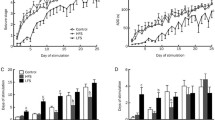In our study, we tried, first, to elucidate whether induction of emotional behavior resulting from stimulation of the dorsomedial hypothalamus (DMH) influences the development of seizure activity in the course of epileptogenesis within the framework of fast kindling (stimulation of the hippocampus) and, second, to estimate if such stimulation is capable of modulating manifestations of generalized seizures under conditions of the pre-formed “full” epileptic syndrome. Stimulation of the DMH in the above two experimental situations resulted in significant suppression of both electrographic and behavioral manifestations of seizure activity. We hypothesize that the respective emotional reactions can be interpreted as phenomena of instinctive behavior having an adaptive defensive significance. These reactions are related to inhibitory processes providing protection from the development of seizure activity.
Similar content being viewed by others
References
S. J. Swanson, S. M. Rao, J. Grafman, et al., “The relationship between seizure subtype and interictal personality. Results from the Vietnam head injury study,” Brain, 118, 91–103 (1995).
M. Trimble, “Epilepsy and behavior,” Epilepsy Res., 10, 71–79 (1991).
N. C. de Lanerolle, J. H. Kim, R. J. Robbins, and D. D. Spenser, “Hippocampal interneuron loss and plasticity in human temporal lobe epilepsy,” Brain Res., 495, No. 2, 387–395 (1989).
P. Conlon and M. R. Trimble, “MRI in epilepsy: a controlled study,” Epilepsy Res., 2, No. 1, 37–43 (1988).
K. Moritomo, M. Fahnestock, and R. Racine, “Kindling and status epilepticus models of epilepsy,” Prog. Neurobiol., 73, No. 1, 1–60 (2004).
G. Goddard, D. McIntyre, and C. Leech, “A permanent change in brain function resulting from daily electrical stimulation,” Exp. Neurol., 25, No. 1, 295–330 (1969).
R. Adamec and D. McKay, “Amygdala kindling, anxiety and corticotropin releasing factor,” Physiol. Behav., 54, No. 2, 423–431 (1993).
L. Kalynchuk, J. Pinel, D. Treit, et al., “Persistence of the interictal emotionality produced by long-term amygdala kindling in rats,” Neuroscience, 85, No. 3, 1311–1319 (1998).
L. Kalynchuk, “Long-term amygdala kindling in rats as a model for the study of interictal emotionality in temporal lobe epilepsy,” Neurosci. BioBehav. Rev., 24, No. 2, 691–704 (2000).
S. Waxman and N. Geschwind, “The interictal behavior syndrome in temporal lobe epilepsy,” Arch. Gen. Psychiat., 32, No. 4, 1580–1586 (1975).
J. Engel, Jr. Seizures and Epilepsy, PA-FA, Davis, Philadelphia (1989).
R. Fisher and J. Kerrigan, “Vigabatrin. Toxicity,” in: Antiepileptic Drugs, R. Lery, R. Mattson, and B. Meldrum (eds.), Raven Press, New York (1995), pp. 931–940.
G. Paxinos and C. Watson, The Rat Brain in Stereotaxic Coordinates. Academic Press, New York, (1997).
R. J. Racine, “Modification of seizure activity by electrical stimulation: II. Motor seizures,” Electroencephalogr. Clin. Neurophysiol., 32, No. 2, 281 (1972).
B. B. Brown, “Frequency and phase of hippocampal theta activity in the spontaneously behaving cat,” Electroencephalogr. Clin. Neurophysiol., 24, No. 1, 53–62 (1968).
G. Buzsaki, Lai-Wo Leung, and C. H. Vanderwolf, “Cellular bases of hippocampal EEG in the behaving rat,” Brain Res., 6, No. 1, 139–171 (1983).
J. D. Green and A. J. Arduini, “Hippocampal electrical activity in arousal,” J. Neurophysiol., 17, No. 6, 553–557 (1954).
C. H. Vanderwolf, R. Kramis, T. E. Robinson, “Hippocampal electrical activity during waking behavior and sleep: analysis using centrally acting drugs,” in: Functions of Septo-Hippocampal System. Ciba Foundation Symposium, K. Elliot and J. Whelan (eds.), Vol. 58, London (1978), pp. 199–221.
G. Ferraro, P. Sardo, M. Sabatino, and V. La Grutta, “Locus coeruleus noradrenaline system and focal penicillin hippocampal epilepsy: Neurophysiological study,” Epilepsy Res., 19, No. 1, 215–220 (1994).
T. K. Ioseliani, Z. I. Nanobashvili, and N. A. Khizanishvili, “Changes in seizure activity thresholds of cat brain in various stages of sleep and wakefulness,” Neurophysiology, 6, No. 6, 454–460 (1974).
V. C. Euler and J. D. Green, “Excitation, inhibition and rhythmic activity in hippocampal cells in rabbit,” Acta Physiol. Scand., 48, No. 1, 110–125 (1960).
G. Buzsaki and G. Czeh, “Commissural and perforant path interactions in the rat hippocampus: field potentials and unitary activity,” Exp. Brain Res., 43, No. 3, 429–438 (1981).
G. Buzsaki and E. Eidelberg, “Direct afferent excitation and long-term potentiation of hippocampal interneurons,” J. E. Psychiatry, 48, No. 3, 397–607 (1982).
T. F. Freund and G. Buzsaki, “Interneurons of the hippocampus,” Hippocampus, 6, 347–470 (1996).
S. I. Neophytou, U. E. Aspley, S. Butler, et al., “Effects of lesioning noradrenergic neurons in the locus coeruleus on conditioned and anconditioned aversive behavior in the rat,” Prog. Neuro-Psychopharmacol. Biol. Psychiat., 25, No. 6, 1307–1321 (2001).
F. S. Giorgi, M. Ferrucci, G. Lazzeri, et al., “A damage to locus coeruleus neurons converts sporadic seizures into self-sustaining limbic status epilepticus,” Eur. J. Neurosci., 17, No. 4, 2593–2061 (2003).
G. K. Weiss, J. Lewis, C. Jimenes-Rivera, et al., “Antikindling effects of LC stimulation: Mediation by ascending noradrenergic projections,” Exp. Neurol., 108, No. 1, 136–140 (1990).
J. Kayama, T. Negi, M. Sugitani, and K. Iwama, “Effects of locus coeruleus stimulation of neuronal activities of dorsal geniculate nucleus and perigeniculate reticular nucleus of the rat,” Neuroscience, 7, No. 5, 655–666 (1982).
Z. Nanobashvili, T. Chachua, A. Nanobashvili, et al., “Suppression of limbic seizures by electrical stimulation in thalamic reticular nucleus,” Exp. Neurol., 181, 224–230 (2003).
Author information
Authors and Affiliations
Corresponding authors
Additional information
Neirofiziologiya/Neurophysiology, Vol. 43, No. 4, pp. 337–344, July–August, 2011.
Rights and permissions
About this article
Cite this article
Nanobashvili, Z.I., Chachua, T.R., Bilanishvili, I.G. et al. Peculiarities of the Effects of Stimulation of Emotiogenic Central Structures under Conditions of a Kindling Model of Epilepsy. Neurophysiology 43, 292–298 (2011). https://doi.org/10.1007/s11062-011-9229-x
Received:
Published:
Issue Date:
DOI: https://doi.org/10.1007/s11062-011-9229-x




